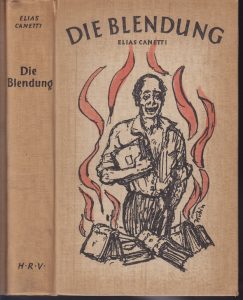Auto de Fe (Elias Canetti)(1935 – trans. into English in 1946)

A surreal representation of pre-World War 2 Mitteleuropa (specifically Germany), Nobel Prize winner’s novel Auto de Fé is an intense and disturbing stew of poverty, insanity and brutality. Dr Peter Kien, who is (at least in his opinion), the world’s greatest Sinologist, leads a strictly structured, hermetic life of study and paper-writing. He subsists on an inheritance, treating offers of professorial chairs with contempt. Although his housekeeper Therese has shown no attention at all to Kien’s 4-room library during the eight years she has lived in his apartment – other than in assiduously dusting it, Kien is enchanted when she pretends interest in a book (“The Trousers of Herr von Bredow”) and marries her. In fact, Therese is virtually illiterate and assuredly insane.
“Her favourite letter was O. From her schooldays she had retained some practice in writing Os. (You must close up your Os as nicely as Therese, teacher used to say. Therese makes the best Os. Three years she stuck in the same class, but that was no fault of hers. It was teacher’s fault. She never could stand her, because in the end she made her Os better even than her. All the children had to copy her Os. Not one of them wanted to copy teacher’s Os anymore).”
When Therese (whose chief components are “skirt, ears and sweat”) excludes Kien from all but one room of his library he marshals his 25,000 volumes with a rousing speech delivered from his library ladder. The Buddhist texts flinch from battle. The war does not go well for the Sinologist.
” Later, despite violent shooting pains, he managed to bend the upper part of his body so far forward that he could see a part of the opposite wall in the adjoining room. Not very much seemed to have altered in that direction. Once he dragged himself out of bed and tottered to the threshold. Full of joyful anticipation, he hit his head against the edge of the door frame even before he had looked through it. He collapsed and fainted away. Therese found him soon after and to punish him for his disobedience let him lie there for another two hours. Then she shoved him back towards the bed, lifted him onto it and tied his legs firmly together with a strong cord.”
Kien is finally driven out into the world, willingly assisted by a red-fisted caretaker whose greatest joy is beating women to death, and a hunchback cripple who aims to become world chess champion. Everyone robs Kien blind. (Perhaps this is why the German name of the book is “Die Blendung” meaning, “The Blinding”? Although of course during an earlier period Kien trained himself to get around most of his apartment with his eyes shut in order not to see the furniture bought by Therese). This middle section of the book – a long mess of extreme violence, fury and weird, dark ambling – is hard to read (leavened only by the humour of Kien’s attempts to save books from being pawned.) The ending comes as a relief to all.
Aside from being too long in parts, this is a superb, absurd, sometimes funny and always fascinating novel of the ilk of (the more accessible) The Melancholy of Resistance by Krasznahorkai or Moravagine by Cendrars. The first section in particular, is magnificent Throughout, Canetti’s prose is crisp and his vision profound; deftly translated in the Picador issue by C V Wedgwood.
Leave a comment...
While your email address is required to post a comment, it will NOT be published.



0 Comments